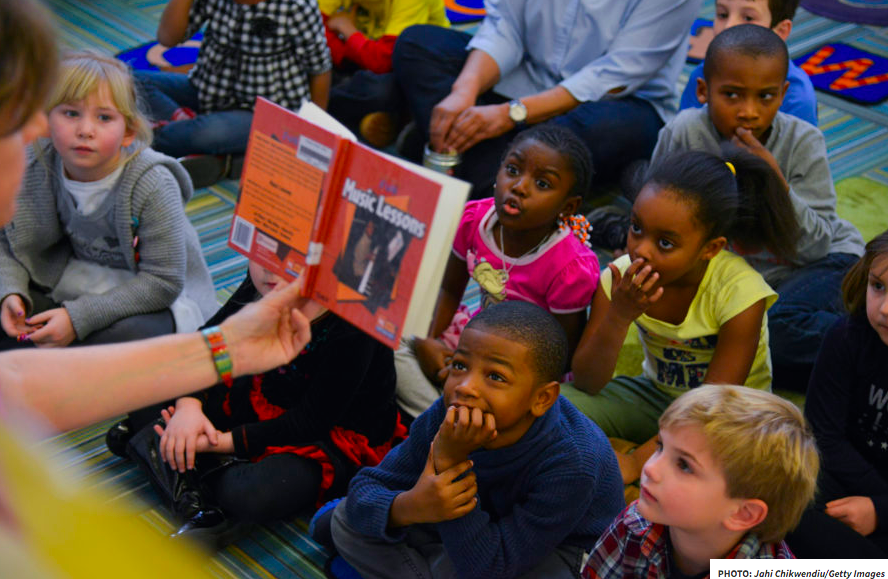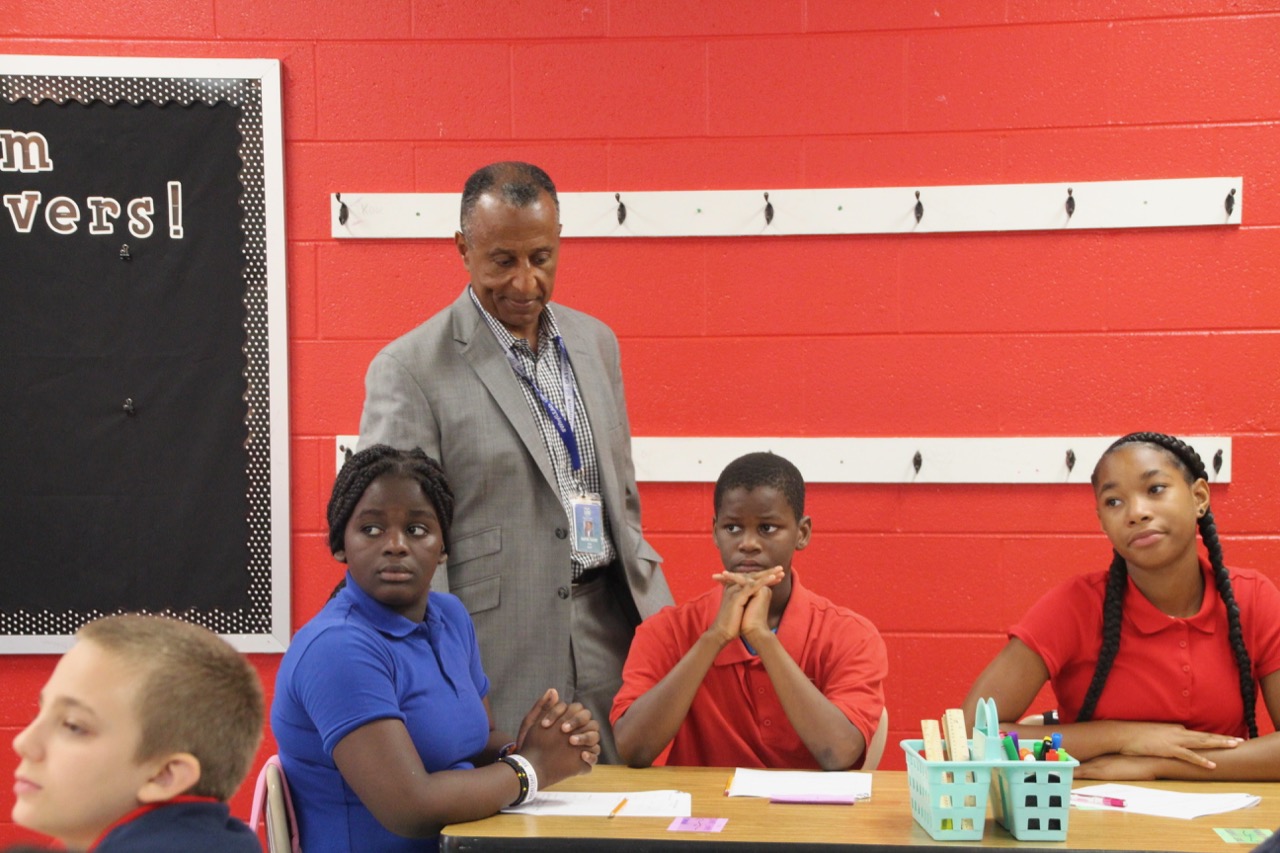
America’s schools are more diverse than ever. But the teachers are still mostly white.
Almost three-fourths of Nashville’s public school population are students of color. In contrast, a look at Nashville teachers reveals the opposite— with 72% of teachers identifying as white (according to MNPS warehouse data received by the Scarlett Family Foundation).
This racial gap between students and educators reflects a national trend, the Washington Post found, as America’s public school population becomes more diverse, but the educator workforce does not.
In a recent article, the Washington Post takes a closer look at school district data and provides insight into what some cities are doing to address this growing racial gap:
Nationally, a Washington Post analysis of school district data from 46 states and the District of Columbia finds that only one-tenth of 1 percent of Latino students attend a school system where the portion of Latino teachers equals or exceeds the percentage of Latino students.
It’s only marginally better for black students: 7 percent were enrolled in a district where the share of black teachers matches or exceeds that for students. Among Asian students, it was 4.5 percent.
Meanwhile, 99.7 percent of white students attended a district where the faculty was as white as the student body, The Post found.
Over time, the ranks of teachers of color have grown. In 1988, 87 percent of public school teachers were white. By 2016, 80 percent were, according to federal data.
Nonetheless, the racial gap between teachers and students has widened as more young people of color have enrolled each year. In 1994, two-thirds of public school students were white; by 2016, fewer than half were.
Read more and explore their data to see how Nashville compares.
Read More
5 Things Districts Can Do to Keep Ahead of Population Changes — and Avoid Enrollment, Planning and Budgetary Disasters
As Nashville continues to be one of the fastest growing cities in the nation, school districts in the region must keep up with the population changes – especially when considering how to adjust their planning and resources. Today, Metro Nashville Public Schools must grapple with dramatic shifts in enrollment— particularly as some regions of the city see schools literally “bursting at the seams” while others see multi-year trends downward.This is a challenge Brian Eschbacher, former Executive Director of Planning and Enrollment for Denver Public Schools (DPS), knows well. In The74, Eschbacher explains how he helped the district weather complex population changes brought about by an enrollment boom, and what other school districts can learn:
During my seven years as executive director of planning and enrollment services for Denver Public Schools, our urban district was among the fastest-growing in the country, gaining more than 20,000 students over 10 years. Since 2017, that trend has slowed, with growth continuing in some neighborhoods but not others. But our team was well-positioned to deal with these changes because of a series of strategies that allowed us to detect, assess and respond to changes in the student population proactively.
Unfortunately, too many large districts lack the tools to respond nimbly to complex population trends. They can take a cue from Denver and other cities by adopting five practices that can prevent unforeseen enrollment, planning and budgetary disasters. More often than not, districts with these systems in place have adopted versions of the portfolio strategy for district management, with autonomous, accountable schools, equitable parent-choice systems, and a central office that focuses on quality assurance, support and high-level strategic planning rather than day-to-day school decisions. But any district can consider adopting some or all of these strategies, whether or not the “portfolio” model is in place.
Photo By Raymond Boyd/Getty Images
Read MoreSix-Figure Price Tags Are Coming to Colleges
The rising cost of college, particularly at the nation’s most prestigious institutions, could soon top $100,000. As these numbers continue to rise, students and families will inevitably be priced out of the most selective— and elite— colleges.
Although many families receive some amount of financial aid to offset the sticker price (the full cost of tuition and fees), colleges depend on tuition revenue more today than they have in the past. Higher Ed institutions face a choice: to stomach an uncertain financial future, or to exclude the many, many students unable to pay such lavish prices for a college education.
The Atlantic explains this trend, and what it means for the future of college affordability:
As admission rates have dropped, the cost of attendance has increased—a correlation seen at many highly selective schools. By 2025, the University of Chicago’s sticker price is predicted to pass the $100,000 mark, which would make it the first U.S. college where attendance costs six figures, according to a new analysis by The Hechinger Report, an education-news outlet. The analysis suggests at least a handful of other U.S. colleges will follow suit soon after Chicago hits that milestone, including California’s Harvey Mudd College, New York City’s Columbia University, and Texas’s Southern Methodist University.
Read MoreAnd after that, given the way American higher education has been going, it likely won’t be long before six-figure prices are common among selective colleges and universities. The [colleges] that are expensive are the ones that students want to apply to,” explains the Seton Hall University professor Robert Kelchen, who studies higher-education finance. “Being expensive is seen as being good—if one [elite] college is 20 percent cheaper than another [elite] college, students are going to wonder what’s wrong with it.

Tennessee edges toward the top half of states on the Nation’s Report Card, thanks to drops elsewhere
This week, the National Assessment of Educational Progress (NAEP) released results from its 2019 assessment. Called “The Nation’s Report Card,” NAEP is a nationwide education assessment administered by the federal government every other year to track student achievement. This year’s results revealed that while most states remained flat or declined in reading and math, Tennessee’s student scores at saw either no change, or some small improvement.
The Nation’s Report Card named early literacy as a nationwide challenge. Only 35% of Tennessee’s 4th graders are considered at or above NAEP proficiency in reading, the same as the national average.
The Scarlett Family Foundation recently released a data resource that focuses on specifically on early literacy in Metro Nashville Public Schools. Only 3 in 10 third grade MNPS students are reading on track, a number that has not moved in the last three years.
Chalkbeat Tennessee dives deeper into Tennessee’s results:
Read MoreTennessee elementary and middle school students improved or held steady on national tests this year while scores in many other states fell, lifting the Volunteer State’s national rankings to solidly in the middle of the pack, according to results released on Tuesday.
The state’s fourth-graders recovered losses from two years ago in math and maintained their reading scores. Meanwhile, eighth-grade scores in both subjects were up slightly but statistically flat for a third straight testing year going back to 2015 under the National Assessment of Educational Progress, also known as NAEP. The exam is given every two years to provide a snapshot of U.S. student achievement for the Nation’s Report Card.
With the showing, Tennessee defied national downward trends and edged closer to — but still fell short of — its ambitious goal of moving into the top half of states by 2019 under the strategic education plan developed five years ago under former Gov. Bill Haslam.
In a city where low literacy levels ‘take your breath away,’ here’s how one Detroit school is teaching third-graders to read
What happens when 5,000 students leave third grade without reading on grade level— year after year? That is the challenge facing the city of Detroit, Michigan.
Unfortunately, Detroit is far from alone in this third-grade literacy crisis. In fact, Nashville’s numbers rival Detroit’s. With only 28.8 percent of Metro Nashville Public Schools students on track in English Language Arts , 4500 students left third grade last year without achieving reading proficiency.
Early literacy must be treated as a top, city-wide priority. That’s why, in the month of October, the Scarlett Family Foundation will be releasing a new data tool that will allow our community to explore the third grade literacy challenges facing Nashville.
Chalkbeat Detroit is highlighting how city schools are working to improve third grade literacy:
Read More“Three boys sat down around a table at Detroit Premier Academy and opened up their picture books. It was the beginning of the school year, and the race was on.
Their teacher, Whitney Vanatta, showed them an index card with the letters ‘Ck’ written on it.
“‘Ck’ says ‘kuh,’” she said.
“Kuh,” they echoed.
The lesson was designed to help the students learn the basic building blocks of English, sound by sound. It wouldn’t be out of place in any kindergarten classroom.
But these weren’t kindergartners — they were third-graders who were badly behind in reading.
They are far from alone. When Michigan’s controversial new “read or flunk” law goes into effect this year, as many as 5,000 third-graders who are reading on a second-grade level or below will be at risk of being held back.
Tennessee graduation rate hits all-time high in the 2018-19 school year
The state of Tennessee released graduation data for the 2018-2019 school year. There’s good news: the graduation rate has increased— reaching 89.7%— and is the highest the state has ever seen.
The Tennessean shares the key takeaways:
The state increased its overall graduation rate to 89.7% and gained half a percentage point over the previous year. Over 72,000 students graduated in 2018-19, with 183 graduates over the previous year, according to state numbers.
The state’s graduation rate is the highest-ever for the state, which has steadily seen increases since changes made in 2011.
Tennessee Education Commissioner Penny Schwinn celebrated the accomplishment, but said she believes the state can top this year’s results.
“Ultimately, I would like to see all 130 districts that serve high school students have a 90 percent graduation or better,” she said. “That’s something my team will be very focused on over the next four years, along with making sure those students have a career or college path in mind the day they walk across the stage to get that diploma.”
Metro Nashville’s graduation rate also increased by two percentage points, to 84.7%. The graduation rate is important, but it does not answer a deeper, more critical question: Are these graduates ready for college or career when they leave high school?
The state also measures readiness by the percent of students who score a 21 on the ACT and graduate on time, called a “Ready Graduate” metric. While those updated numbers have not yet been released, last year, the percentage of MNPS graduates qualifying as Ready in the 2017-2018 school year was only 24%.
The purpose of high school is greater than just reaching Graduation Day— we must ensure that our students are gaining the skills and knowledge they need for the next step in their lives.
Read MoreMillions of Students Are Chronically Absent Each Year. Improve School Conditions and More Kids Will Show Up, Report Argues
This week, the American Institutes for Research and Attendance Works released a new report on the issues contributing to student chronic absenteeism (students missing more than 18 days of school a year). In it, the authors zoom in on the factors that affect student attendance, factors both inside the school building and out. The report also makes recommendations for encouraging attendance, including the development of a welcoming and safe environment for students, strong relationships between adults and students, and increased access to engaging learning opportunities.
The education news website, The 74 highlighted key takeaways from the report:
An obvious educational rule of thumb is that in order for students to learn at school, they first have to show up.
But with millions of children counted “chronically absent” each year, a new report argues that educators can improve attendance by first making their schools more welcoming places to attend.
The report, released Tuesday by the American Institutes for Research and Attendance Works, argues that schools can improve student attendance if children feel safe and included at school. A comprehensive strategy to improve students’ health and safety, sense of belonging, emotional well-being and academic engagement are all key to combating chronic absences, according to the report.
Those elements work together to “pull people in or push them out,” said David Osher, vice president at the American Institutes for Research and a co-author of the report.
“You want school to be a place people want to be,” he said. “For too many students, particularly too many students who face economic disadvantage and often are culturally marginalized, what they experience in school tends to not be highly engaging.”
Chronic absenteeism challenges Metro Nashville Public Schools, particularly at the high school level. A third—and in some schools, even more— of MNPS high school students miss at least 18 days of school per year. If our goal is to see all Nashville students receive a high-quality education, we must contend with the factors that keep students out of the classroom.
Read More
Here’s how two Nashville state-run schools are tackling teacher turnover, low student performance
For years, two Nashville schools, LEAD Brick Church and LEAD Neely’s Bend, have struggled to produce strong academic performance – both were identified by the state as “priority” schools, performing in the bottom five percent of all schools state-wide. Teacher turnover presented another challenge, with about half of all teaching staff leaving LEAD schools each year. But leaders of the charter network knew that in order to improve student outcomes, they had to attract and retain exceptional teachers. LEAD’s chosen strategy: get innovative, and rethink the traditional model of teacher pay.
Chalkbeat Tennessee recently outlined LEAD’s plan to tackle teacher turnover and improve student performance:
“We had to make strategic changes in how we run our charter network because we weren’t getting the results we wanted to see in our ASD schools,” Tucker said. “What was inhibiting our ability to be successful there? We weren’t putting our best people in those schools. We almost started over every year instead of having a core group of teachers come back.”
This school year, LEAD began offering $5,000 bonuses for teachers who have stayed at their school for at least two years. Eight teachers at LEAD qualified for the bonuses.
For educators like Brooks, this was a big deal. But she added that higher pay alone won’t keep teachers.
“Everyone is really excited about this,” Brooks said. “There’s a sense of valuing our hard work, but there’s also an understanding that people have lives outside of school. You hear teachers all the time say, ‘I don’t have a life.’ I think here, that culture is improving.”
The organization also uses a merit-based pay scale that offers its highest-performing teachers up to 10% raise. This year, LEAD created an “advanced teacher” band, which starts at $65,000 and puts teachers on the same pay scale as school administrators. The annual salary for a teacher starting out in Metro Nashville Public Schools is $43,363, and the school district recently announced its own $5,000 bonuses for teachers in low-performing schools.
“We saw our higher-performing teachers want to make more money, and so they would become teacher coaches or join school administration,” said Chris Elliott, LEAD’s head of academics. “But we need to keep our best teachers in the classroom if we’re going to see sustained gains.”
We know teachers are the most significant in-classroom factor for student outcomes. LEAD’s plan to keep excellent teachers in front of students gets us closer to the vision of high-quality education for all.
Read MoreHow to make a difference for public school kids if you don’t have kids in school | Plazas
The state of Nashville’s public schools affects us all, whether we are parents, employers, taxpayers, or a combination of the above. It is key to the health of our city that the next generation, our pool of future leaders, is prepared for success in their academic lives.
We believe that when people come together, incredible things can be accomplished. And if our Nashville community comes together, joining forces to demand that more of our students get the education they need to be successful in the classroom and beyond, we can change the trajectory of public schooling in our city.
We also recognize that the challenges attached to education can seem so big, and so systemic, that it may feel impossible that any one individual could make a difference.
In The Tennesseean, David Plazas shares why this is not the case, and gets detailed on ways in which Nashvillians can help our public school students succeed:
“We pay property taxes to the city, and about 40% of the municipal budget pays for MNPS. Aren’t we doing enough?
After listening to the wisdom of an educator this week, I do not think so. This wise man reminded me: “It’s about the kids, not the system.”
It is a reminder that we could be doing far more to invest in children who will one day take care of us and lead us.
The investment in schools is like investments in parks and public safety. Not everyone may need, like or want to use these services, but they make a community stronger, safer, vibrant and more attractive to longtime and new residents alike.
Educated children make for informed, productive adults invested in the future of generations to come.
Conversely, the consequences of doing nothing or not enough will only perpetuate hopelessness and dysfunction among children who feel nobody cares about them. The result: More unemployment, poverty, crime and idle youth.
We’re convinced – are you? Read more about the ways you can help our students thrive.
Read MoreTennessee students improve on TNReady tests. How did your school do?
Last week, the State of Tennessee released the 2018-2019 TNReady scores, which reveal how students performed on the annual assessment tests. The results help track both student growth, or how much a student has improved over the last year in relation to their peers, and student achievement, which measures student proficiency in specific subject areas. Within the results, there are some bright spots – including improvements in math – but the numbers also reveal that Tennessee has made little improvement in early literacy, a state priority.
Chalkbeat Tennessee provides a breakdown of these scores, as well as a searchable function for student achievement by state, district and school:
Tennessee students improved in nearly every math subject, including algebra and geometry, on the latest state tests. And in English, older students showed gains across the board, although elementary and middle school students showed little or no improvement.
Overall, more than half the schools in Tennessee – 56 percent – improved in most subjects from the previous year, according to a state summary of the TNReady and end-of-course test data. And 41% of all schools registered the highest levels of year-to-year growth, earning a level 4 or 5 under the Tennessee Value-Added Assessment System, known as TVAAS.
Although our state can celebrate improvement in math proficiency, results were much more mixed for ELA (a measurement that includes literacy). It remains true that only one in four third through eighth grade students in Metro Nashville Public Schools is reading on grade level.
We cannot allow three-fourths of Nashville’s students to lag behind in literacy skills. If you’re looking for a way to get involved, consider volunteering for a nonprofit that serves Metro Nashville Schools, like the PENCIL Foundation, Book’em Nashville or the Public Library.
Read More
